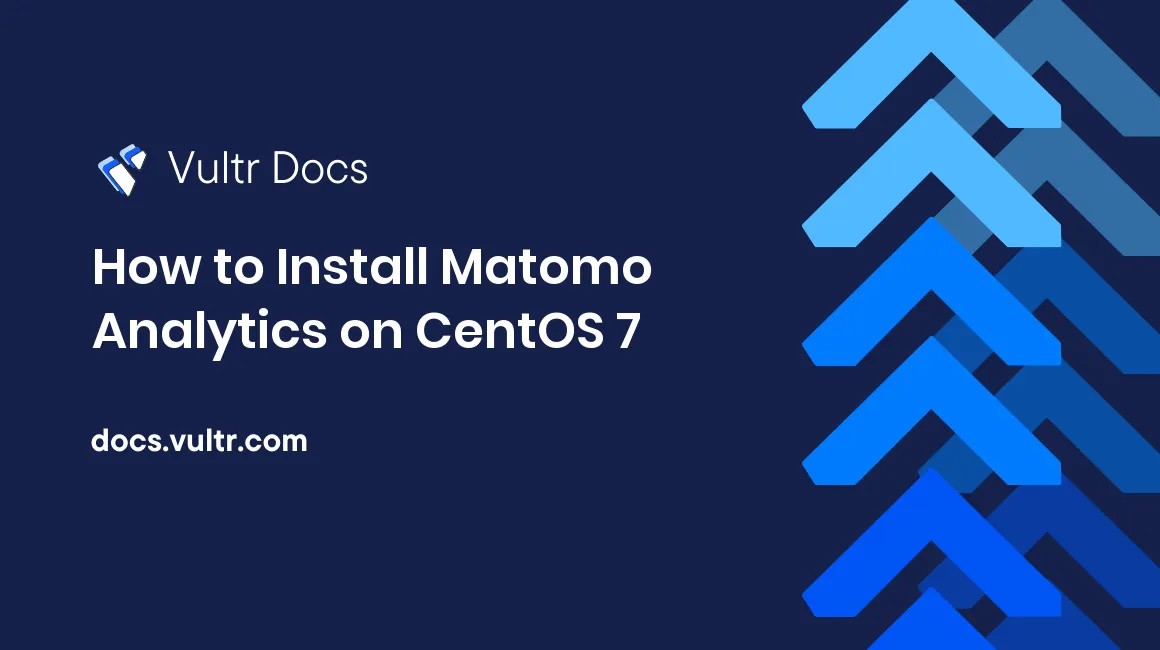
Matomo (formerly Piwik) is an open source analytics platform, an open alternative to Google Analytics. Matomo source is hosted on GitHub. It is a fully featured PHP/MySQL software program that you download and install on your own webserver. In this guide, we will install Matomo on a fresh CentOS 7 Vultr server instance.
Requirements
- Nginx.
- PHP version 5.5.9 or greater.
- MySQL version 5.5 or greater, or MariaDB.
- PHP extensions
pdoandpdo_mysql, or themysqliextension.
Before you begin
Check the CentOS version.
cat /etc/centos-release
# CentOS Linux release 7.5.1804 (Core)Create a new non-root user account with sudo access and switch to it.
useradd -c "John Doe" johndoe && passwd johndoe
usermod -aG wheel johndoe
su - johndoeNOTE: Replace johndoe with your username.
Set up the timezone.
timedatectl list-timezones
sudo timedatectl set-timezone 'Region/City'Ensure that your system is up-to-date.
sudo yum update -yInstall needed packages to finish this tutorial.
sudo yum install -y wget curl vim zip unzip bash-completionDisable SELinux and Firewall.
sudo setenforce 0
sudo systemctl stop firewalld
sudo systemctl disable firewalldInstall PHP and required PHP extensions
Setup the Webtatic YUM repo.
sudo rpm -Uvh https://mirror.webtatic.com/yum/el7/webtatic-release.rpmInstall PHP and required PHP extensions.
sudo yum install -y php72w php72w-cli php72w-fpm php72w-common php72w-curl php72w-gd php72w-mysql php72w-xml php72w-mbstringCheck the PHP version.
php --versionStart and enable php-fpm.
sudo systemctl start php-fpm.service
sudo systemctl enable php-fpm.serviceInstall MariaDB
Install the MariaDB database server.
sudo vim /etc/yum.repos.d/MariaDB.repo
# Copy/paste this to the /etc/yum.repos.d/MariaDB.repo file
[mariadb]
name = MariaDB
baseurl = https://yum.mariadb.org/10.2/centos7-amd64
gpgkey=https://yum.mariadb.org/RPM-GPG-KEY-MariaDB
gpgcheck=1
sudo yum install -y MariaDB-server MariaDB-clientCheck the version.
mysql --versionStart and enable MariaDB.
sudo systemctl start mariadb.service
sudo systemctl enable mariadb.serviceRun the mysql_secure_installation script to improve the security of your MariaDB installation.
sudo mysql_secure_installationLog in to MariaDB as the root user.
mysql -u root -p
# Enter password:Create a new MariaDB database and user, and remember the credentials.
CREATE DATABASE dbname;
GRANT ALL ON dbname.* TO 'username' IDENTIFIED BY 'password';
FLUSH PRIVILEGES;
EXIT;Install and configure Nginx
Install Nginx.
sudo yum install -y nginxCheck the version.
sudo nginx -vStart and enable Nginx.
sudo systemctl start nginx.service
sudo systemctl enable nginx.serviceConfigure Nginx. Run sudo vim /etc/nginx/conf.d/matomo.conf and populate the file with the following configuration.
server {
listen 80;
server_name stats.example.com;
root /var/www/matomo;
location / {
try_files $uri /index.php$is_args$args;
}
location ~ \.php$ {
try_files $uri =404;
include fastcgi_params;
fastcgi_pass 127.0.0.1:9000;
fastcgi_index index.php;
fastcgi_param SCRIPT_FILENAME $document_root$fastcgi_script_name;
}
}Test the configuration.
sudo nginx -tReload Nginx.
sudo systemctl reload nginx.serviceInstall Matomo
Create a document root directory.
sudo mkdir -p /var/www/matomoChange ownership of the /var/www/matomo directory to johndoe.
sudo chown -R johndoe:johndoe /var/www/matomoDownload the latest release of Matomo.
cd /var/www/matomo
wget https://builds.piwik.org/piwik.zip && unzip piwik.zip
rm piwik.zip
mv piwik/* .
rmdir piwikChange ownership of the /var/www/matomo directory to nginx.
sudo chown -R nginx:nginx /var/www/matomoRun sudo vim /etc/php-fpm.d/www.conf and set the user and group to nginx. Initially, they will be set to apache.
sudo vim /etc/php-fpm.d/www.conf
# user = nginx
# group = nginxRestart php-fpm.
sudo systemctl restart php-fpm.serviceOpen your web browser and navigate to the URL to which you have uploaded Matomo. You will see the "Matomo Installation Welcome Screen". If there are any problems, Matomo will identify them and offer a solution. Follow the instructions on the screen to finish the Matomo installation.
No comments yet.